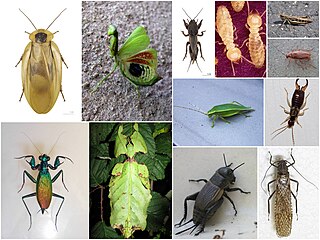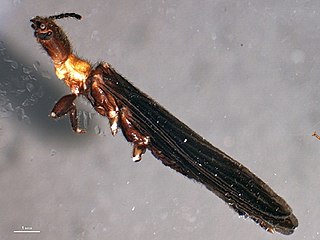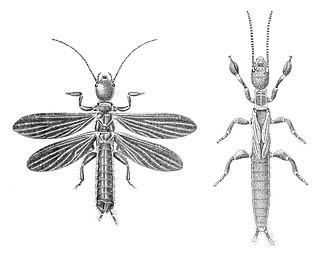
The order Embioptera, commonly known as webspinners or footspinners, are a small group of mostly tropical and subtropical insects, classified under the subclass Pterygota. The order has also been called Embiodea or Embiidina. More than 400 species in 11 families have been described, the oldest known fossils of the group being from the mid-Jurassic. Species are very similar in appearance, having long, flexible bodies, short legs, and only males having wings.

Nepticulidae is a family of very small moths with a worldwide distribution. They are characterised by eyecaps over the eyes. These pigmy moths or midget moths, as they are commonly known, include the smallest of all living moths, with a wingspan that can be as little as 3 mm in the case of the European pigmy sorrel moth, but more usually 3.5–10 mm. The wings of adult moths are narrow and lanceolate, sometimes with metallic markings, and with the venation very simplified compared to most other moths.
Edward Shearman Ross was an American entomologist. He majored in entomology at the University of California, Berkeley. Before his PhD was conferred, he worked as curator of insects at the California Academy of Sciences. He wrote many scientific and popular articles about the biology of the insects.
Richard Charles Froeschner was an American entomologist. He was born in Chicago, Illinois. He married Elsie Herbold Froeschner, a scientific illustrator, on October 6, 1940. He attended the University of Missouri in Columbia, Missouri.

The cohort Polyneoptera is a proposed taxonomic ranking for the Orthoptera and all other Neopteran insects believed to be more closely related to Orthoptera than to any other insect orders. These winged insects, now in the Paraneoptera, were formerly grouped as the Hemimetabola or Exopterygota on the grounds that they have no metamorphosis, the wings gradually developing externally throughout the nymphal stages.

Haploembia solieri or bicolored webspinner is a species of webspinner in the family Oligotomidae. It is found in Europe, Northern Asia, and North America. Unlike Haploembia tarsalis, which reproduces asexually, H. solieri reproduces sexually. Adult specimens of H. solieri are orange and black and around 11 mm long.

Haploembia is a genus of webspinners in the family Oligotomidae. There are at least three described species in Haploembia. They are native to the Mediterranean, but have been observed in the western United States, and are adventive elsewhere.

Oligotomidae is a family of webspinners in the order Embioptera. There are about 6 genera and at least 40 described species in Oligotomidae.
Tigava is a genus of lace bugs in the family Tingidae. There are about 15 described species in Tigava.
Anisembia is a genus of webspinners in the family Anisembiidae. There is at least one described species in Anisembia, A. texana, discovered by Krauss in 1911.
Diradius is a genus of webspinners in the family Teratembiidae. There are about 15 described species in Diradius.
Andesembiidae is a family of webspinners in the order Embioptera. There are at least two genera and about seven described species in Andesembiidae.
Archembiidae is a family of webspinners in the order Embioptera. There are at least 2 genera and about 12 described species in Archembiidae.

Australembiidae is a family of webspinners in the order Embioptera. There is at least one genus, Metoligotoma, in the family Australembiidae.

Clothodidae is a family of webspinners in the order Embioptera. There are about 8 genera and 25 described species in Clothodidae.

Embiidae is a family of webspinners in the order Embioptera. There are more than 20 genera and 80 described species in Embiidae.
Paedembiidae is a family of webspinners in the order Embioptera. There are at least three genera and three described species in Paedembiidae.
Scelembiidae is a family of webspinners in the order Embioptera. There are about 16 genera and more than 40 described species in Scelembiidae.

Howard Radclyffe Roberts Jr. was an American entomologist known for his work on grasshoppers. His 1941 University of Pennsylvania Ph.D. dissertation was an early work highlighting the role phallic structures could play in grasshopper taxonomy. While serving in World War II, he and Edward Shearman Ross cowrote The Mosquito Atlas, used by the armed forces to identify malaria-transmitting mosquitos. Roberts worked for the Academy of Natural Sciences of Philadelphia (ANSP), serving as its managing director from 1947 to 1972. He described dozens of grasshopper species from North and South America, and also is the eponym of several taxa named in his honor.







